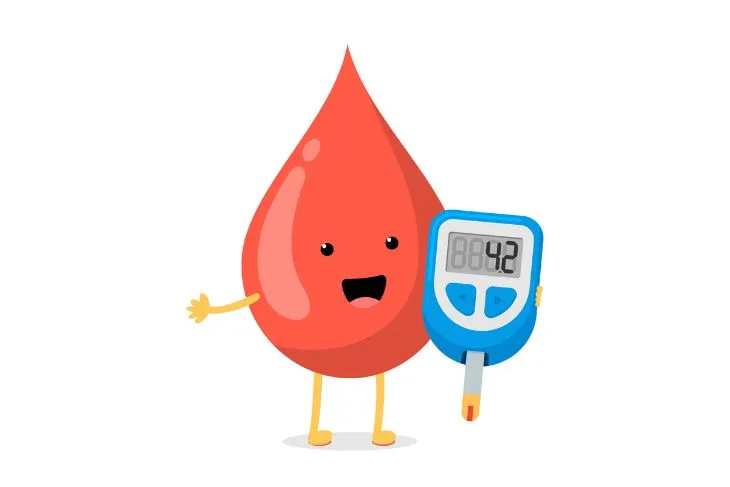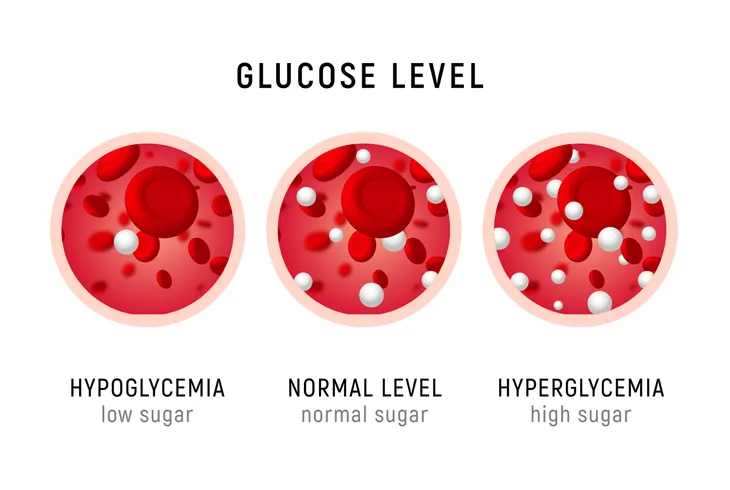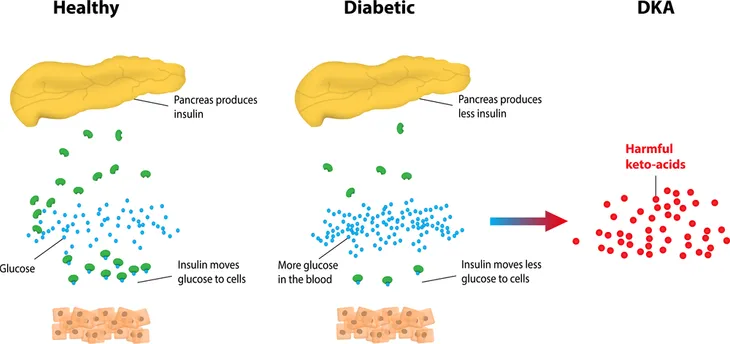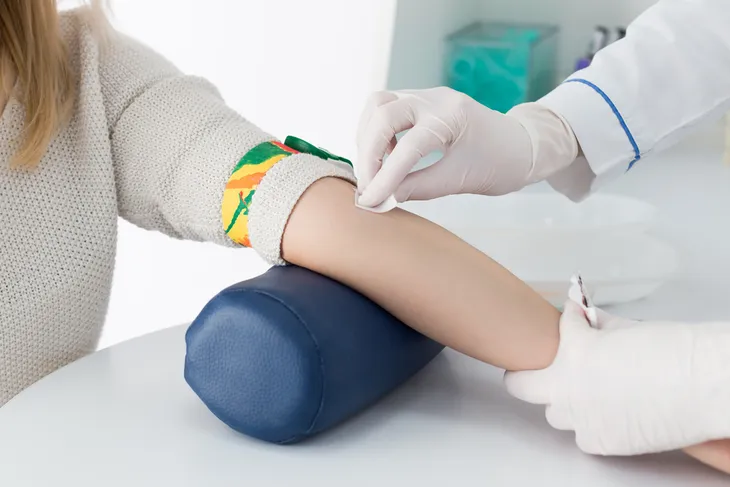- LADA (latent autoimmune diabetes in adults), also known as type 1.5 diabetes, occurs when antibodies attack the hormone-producing cells of the pancreas.
- Symptoms often don’t appear for a long time, but when they do they include frequent thirst, increased urination, unexplained weight loss, blurred vision, and tingling nerves.
- While the exact cause of type 1.5 diabetes is unknown, it’s thought to be genetic with an environmental trigger that sets the process in motion.
- Oral medication can help at first, but in the end the traditional diabetes medication will be necessary.
When we think of diabetes, we often think of the two types — type 1 diabetes and type 2 diabetes. But there are other forms of this disease that don’t necessarily fit the mold of these two types. LADA (latent autoimmune diabetes in adults) is one of these. While it shares some similarities with type 1 and type 2 diabetes, there are key differences.
Like type 2 diabetes, type 1.5 diabetes comes on gradually, but a person’s beta cells will stop functioning much faster. According to Healthline, 10-percent of people with diabetes have LADA. To learn more, here’s everything to know about type 1.5 diabetes, including the symptoms, causes, and treatment options…
What is Type 1.5 Diabetes?
While the official name for this form of diabetes is LADA, it’s often referred to as type 1.5 diabetes. Similar to type 1 diabetes, LADA occurs “because your body makes antibodies that cause the immune system — your body’s defense against germs — to attack the [hormone that regulates glucose in the blood]-making cells of your pancreas,” writes WebMD.
If the body can’t regulate glucose in the blood, it also can’t control blood sugar levels. Even though it is still a serious illness, WebMD reassures that unlike type 1 diabetes, the symptoms with LADA progress slowly and often don’t require treatment for many months or years after a diagnosis.
Most Common Symptoms
Symptoms don’t appear right away due to the gradual rate that the beta cells are destroyed. It’s not until the beta cells are down to about 10-percent of their typical number that any signs will show up, explains John B. Buse, MD, PhD, director of the Diabetes Center at the University of North Carolina School of Medicine in Chapel Hill to Health.com.
When symptoms do occur, they can be similar to type 1 and type 2 diabetes. For example, people with LADA will find they are often thirsty, have to urinate frequently, get blurry vision, and lose weight even with an increased appetite, notes WebMD. Additional symptoms include frequent infections, weakness, fatigue, dry itchy skin, and tingling in the hands and feet.
Cause of Type 1.5 Diabetes
It’s still unclear why in some people, antibodies that are meant to guard against foreign invaders instead attack the hormone-producing cells. It’s likely due to genetics, says Health.com. In fact, research has discovered that type 1.5 diabetes has a genetic component that overlaps with type 1 and 2 (but is more closely related to type 1) diabetes. And while genetics plays a big role, Health.com adds it’s an environmental trigger that usually sets the process in motion.
“You have to have the right genetic predisposition, but something has to set your immune system off on a course to destroy the cells that make [the hormone that regulates glucose in the blood],” explains Dr. Buse to the source. “It’s unclear what those are.” Research has found links to weight, viral infections, and stress, but nothing is definitive. Health.com notes it’s also plausible type 2 diabetes morphs into type 1.5 diabetes.
Complications of Type 1.5 Diabetes
The potential complications of type 1.5 diabetes are similar to those of type 2 diabetes. According to Medical News Today, people with LADA are at an increased risk for microvascular complications. This includes kidney damage, nerve damage that causes pain, tingling, or a loss of sensation in the hands and feet, as well as disorders of the eye and vision.
It’s also believed that people with type 1.5 diabetes may have a higher chance of developing cardiovascular conditions. This risk may even be higher than people with type 2 diabetes. “People with LADA may have high blood cholesterol levels than those with type 2 diabetes,” adds the source.
Diabetic Ketoacidosis (DKA)
Another complication of type 1.5 diabetes is diabetic ketoacidosis (DKA). This complication occurs when the “cells are unable to receive the glucose that they need, and the body instead burns fat for energy,” explains Medical News Today. This process produces ketones which can cause a person’s breath to develop a fruity odor.
Diabetic ketoacidosis is a potentially life-threatening condition that can lead to diabetic coma, warns the source. Blood sugar levels are so high, they lead to high levels of acid in the bloodstream. Some symptoms to watch for are signs of high blood sugar, unintentional weight loss, vomiting, weakness, and changes in mental state.
Risk Factors
The main cause of type 1.5 diabetes is genetic, however there are also some risk factors that can increase a person’s chance of developing this condition. Medical News Today lists the most likely risk factors as obesity or excessive weight, low birth weight, and low physical activity. Another potential risk factor is psychosocial stress.
“Researchers suggest that people with multiple risk factors may have higher chances of developing LADA,” writes the source. For example, if a person was born with a low birth weight and is overweight as an adult, it can increase their chances of developing LADA.
When to See a Doctor
Anyone who suspects they might have diabetes, should contact their doctor. Signs to watch for that require a visit to the doctor are excessive thirst or hunger, as well as frequent urination, says Medical News Today. The doctor can easily test for diabetes which involves blood tests looking for several blood sugar markers.
It’s important to see a doctor promptly. Those who wait or delay can develop DKA. If this occurs it means the diabetes is getting worse. People with symptoms of DKA need to see a doctor immediately as this condition is life-threatening, warns the source.
Diagnosing Type 1.5 Diabetes
People usually don’t receive a type 1.5 diabetes diagnosis until adulthood. WebMD states that it’s usually around the age of 30 or older, and sometimes is mistaken for type 2 diabetes. But this usually gets sorted once they start taking the standard oral medication and it doesn’t work.
According to WebMD, the only way to confirm a type 1.5 diabetes diagnosis is through a blood test checking for the specific antibodies (glutamic acid decarboxylase antibodies [GAD]) attacking the hormone-making cells of the pancreas. Another way to test is to check C-peptide levels to find out how much of the hormone that regulates glucose in the blood the body is actually making.
Doctors will also look for specific characteristics, such as a family history of autoimmune disease, not being obese, and weight loss, notes Health.com.
Misdiagnosing Type 1.5 Diabetes
Due to the sometimes subtle differences between type 1.5 diabetes and other types, healthcare providers can mistake it for type 2 diabetes. Health.com states that as many as 2 to 12-percent of adult-onset diabetes could be a result of LADA which means many people who have 1.5 diabetes are receiving the wrong treatment.
For example, both type 2 and type 1.5 diabetes develop later in life, but while medication and lifestyle changes can help manage type 1.5 diabetes, their beta-cell function will continue to diminish. While type 1.5 diabetes progresses slower than type 1 diabetes, Health.com points out the beta-cell function diminishes faster. This means glucose-lowering treatments may work at first, but will eventually become ineffective once the beta-cell function declines past a certain point.
Overall, Health.com explains this misdiagnosis usually happens because of a lack of awareness around type 1.5 diabetes, and insufficient testing. More research is necessary to develop a diagnostic guideline so treatment can be implemented early on.
Treatment Options
Type 1.5 diabetes treatment falls somewhere between type 1 and type 2 diabetes. While it does require treatment, the gradual onset means patients might not need the medication right away, notes Healthline.
Oral medication can help at first, but in the end the traditional diabetes medication will be necessary. However, there are many different types and regimes that may work. The dosage can even vary on a daily basis, so the best thing to do is monitor glucose levels closely with frequent blood sugar testing, adds the source.
Type 1.5 Diabetes Prognosis
The prognosis for people with type 1.5 diabetes is similar to those with other types of diabetes. If blood sugar levels are left high for a long period of time, it can lead to serious complications. These include kidney disease, cardiovascular problems, eye disease, and neuropathy. All of these can affect the prognosis, says Healthline. However, with proper management, most of these complications are avoidable.
In the past, a type 1 diabetes diagnosis meant a shorter life expectancy. But diabetes treatment has come a long way. Today, people with diabetes can live a normal life expectancy. “Some experts feel that getting treated with [medication] from the outset of your diagnosis can help preserve your beta cell function,” writes Healthline. If this is true, an early diagnosis means a good prognosis.
How to Prevent Type 1.5 Diabetes
Unfortunately, there is no surefire way to prevent type 1.5 diabetes. Many of the factors that come into play are genetic and out of our control. The best hope is to get an early and correct diagnosis so the effect of symptoms is manageable and limited. This can also help avoid any complications from 1.5 diabetes, says Healthline.
Total prevention isn’t possible, but Dr. Buse tells Health.com that diet modification in the early stages of the disease can help. For example, a carbohydrate-restricted diet works well with type 1.5 diabetes, as it does with type 2 diabetes.















